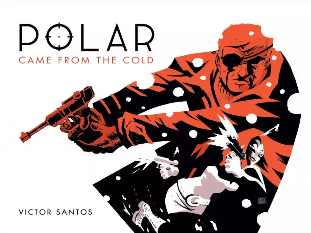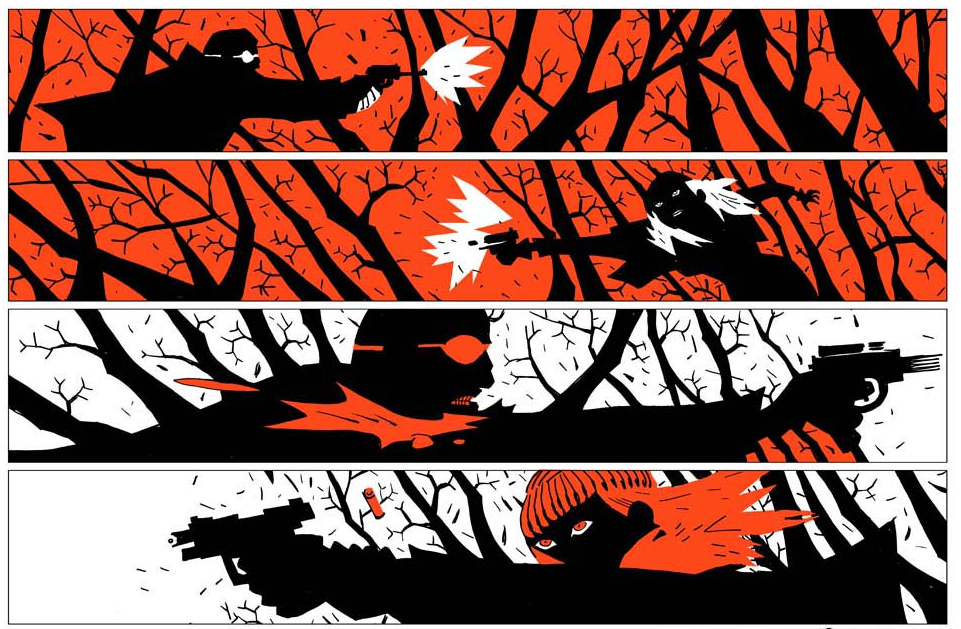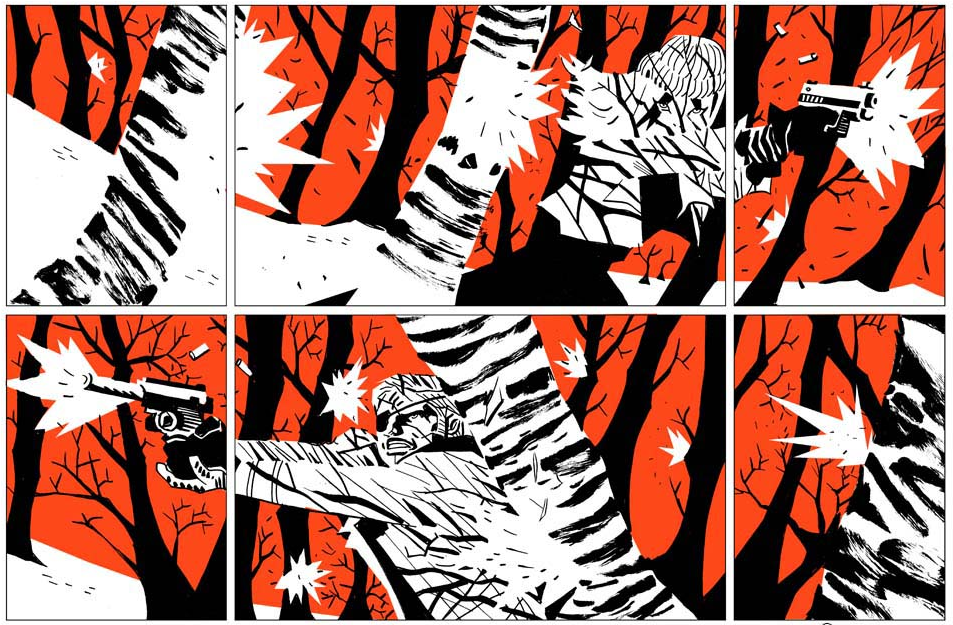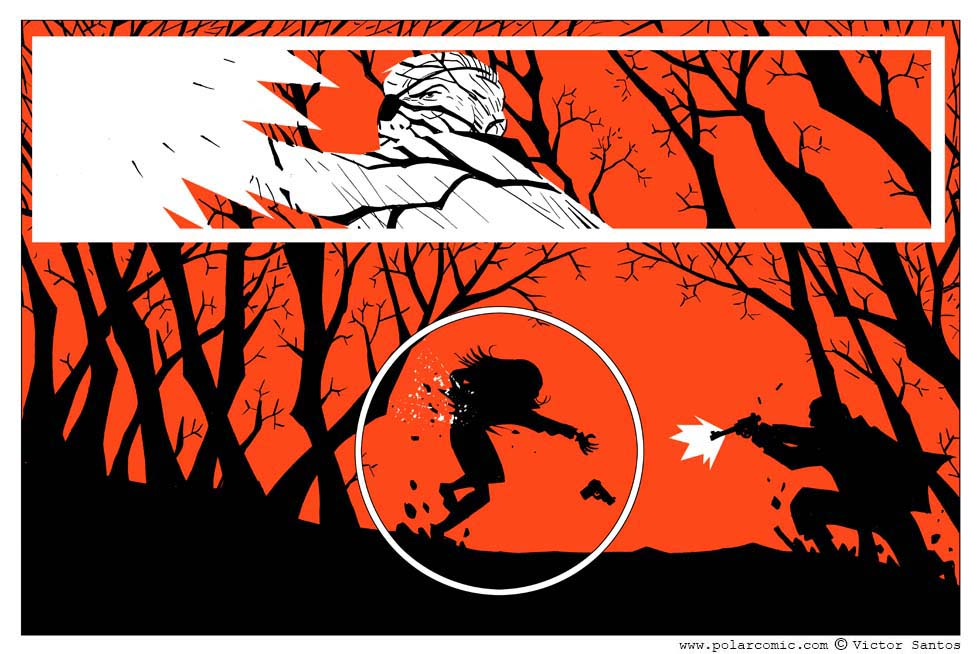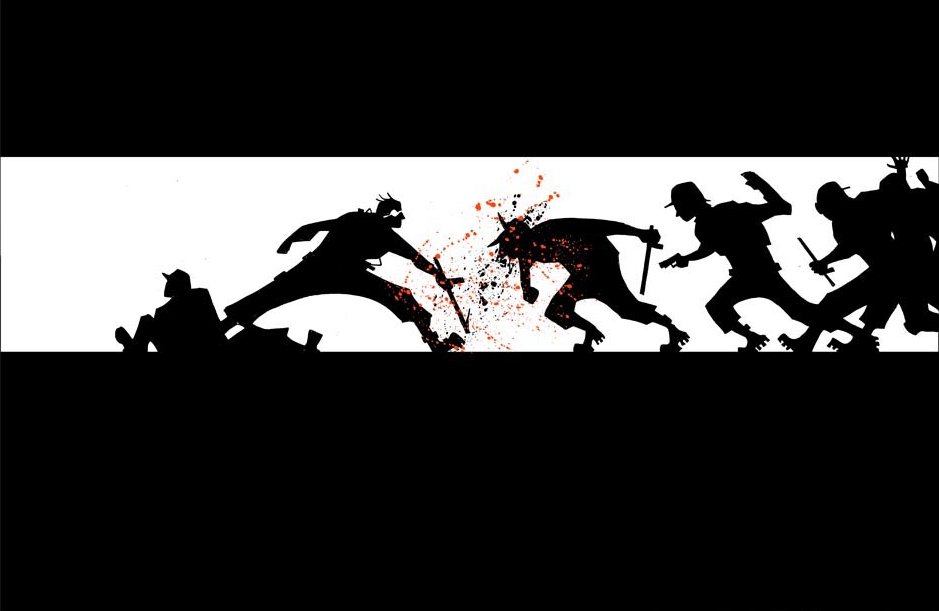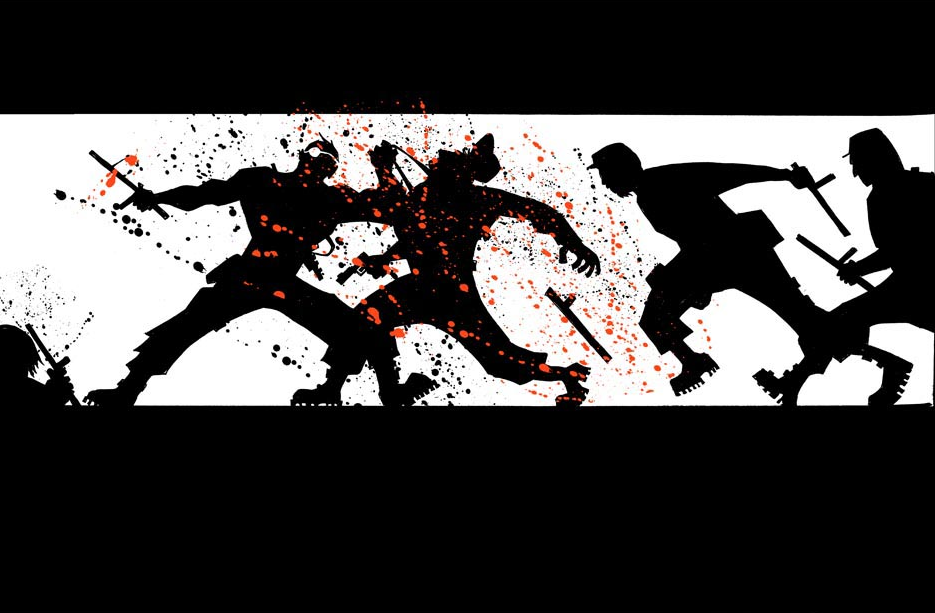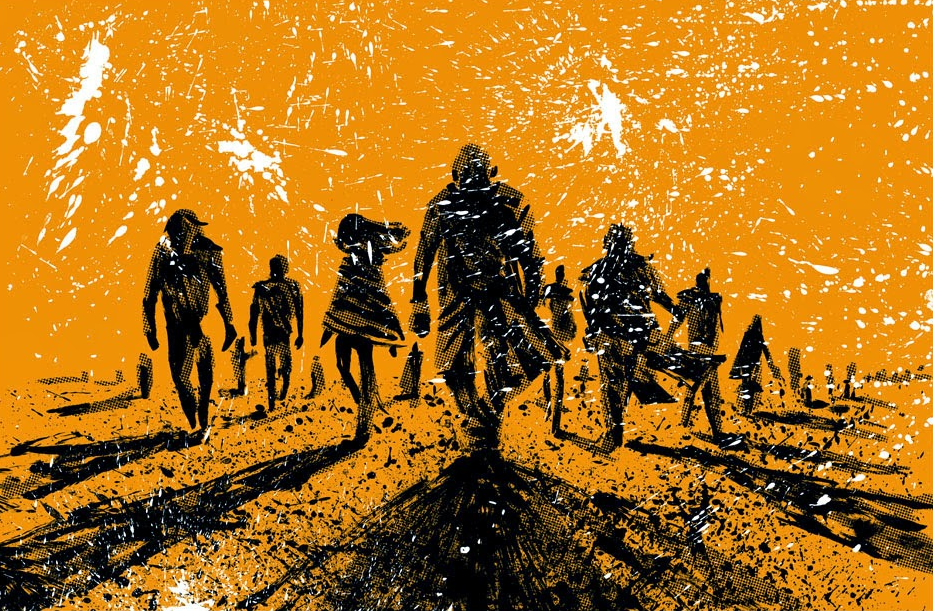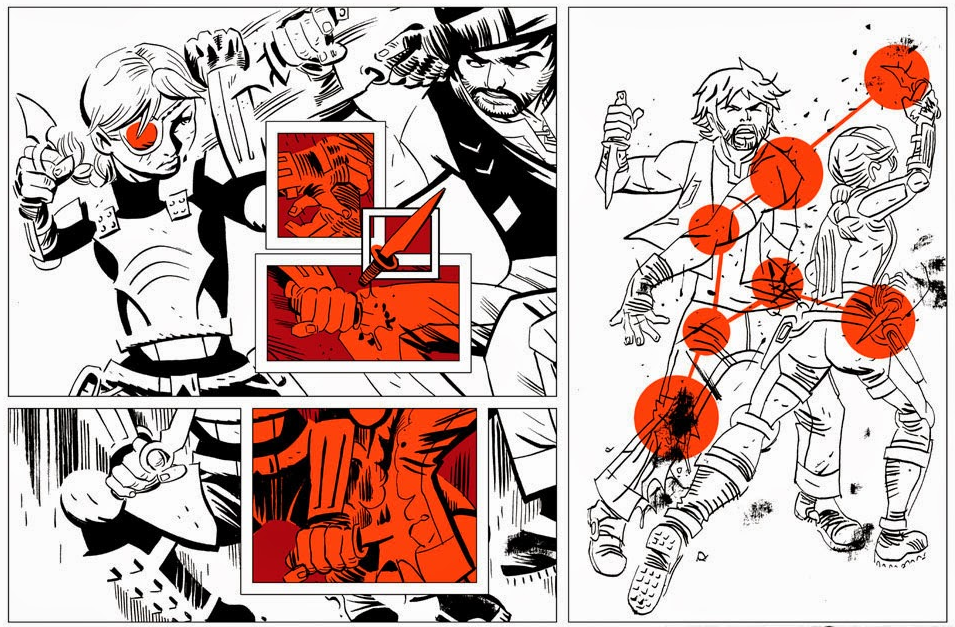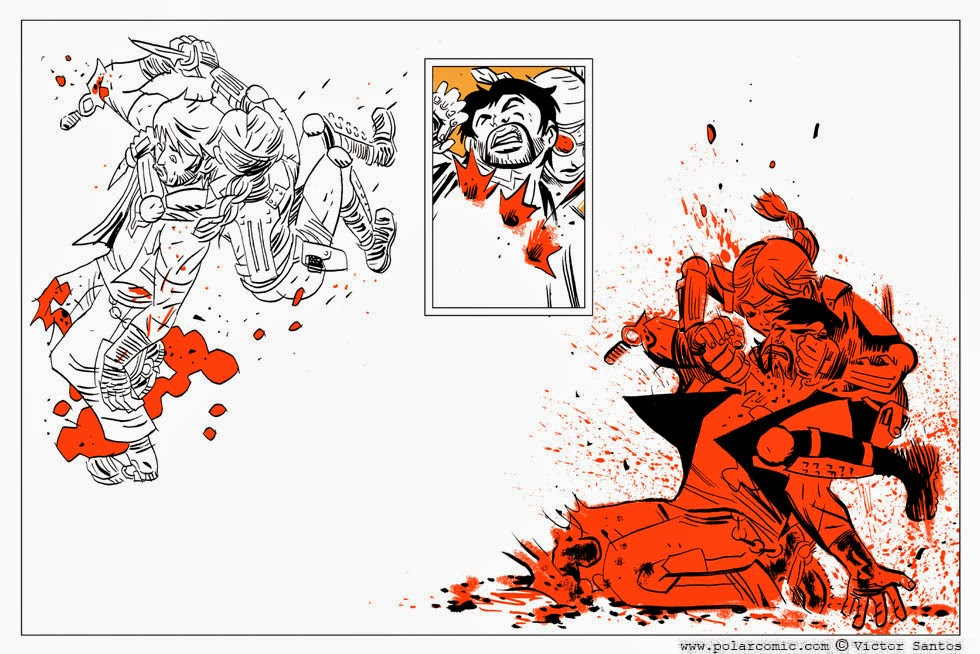July is the month of spy comics at Gotham Calling. This year, I’ve discussed the black & white indie series Queen & Country and the over-the-top early adventures of the one-eyed super-spy Nick Fury. Today, I’m looking at a more recent indie comic that also features gritty black & white art and a badass one-eyed secret agent, but it takes those elements in a whole other direction.
Victor Santos’ Polar started out as a silent webcomic before Dark Horse expanded it into a series of gorgeous graphic novels peppered with hardboiled dialogue (not much, though, fortunately). The series stars Black Kaiser, an unstoppable assassin / former Soviet spy who is forced out of retirement and goes on an international killing spree. This derivative story gets somewhat more complex as the plot unfolds, but the story isn’t really the main attraction here – Santos’ phenomenal art is.
Polar is told through minimalist, stylized drawings with plenty of silhouettes and ample negative space. The colors are even more minimalistic: just black and white and the occasional bit of red-tinged orange (often used for lipstick or blood, although also used for background atmosphere when it suits the mood). Given the comic’s channeling of old-school pulp fiction and Cold War-era potboilers, this color scheme will sound appropriate to anyone who has read Robert Miklitsch’s The Red and the Black: American Film Noir in the 1950s. The result is powerfully dynamic and highly expressionistic, especially during the action scenes:
Besides the blatant homage to Jim Steranko, there are echoes of Darwyn Cooke’s Parker, of Warren Ellis’ and Cully Hamner’s Red, and, particularly, of Frank Miller’s Sin City. Like the latter, Polar trades in film noir tropes and aesthetics while taking them to almost abstract extremes, from the ultra-macho protagonist to the pageantry of femme fatales, from the cynical worldview to the kinky links between sex and violence. Moreover, Santos has a similar flair for deploying elements such as snowflakes, shadows, and bloodstains to maximum effect (in terms of both mood and symbolic undertones).
Polar’s website mentions that the series is also meant to pay tribute to artists Jose Muñoz, Alberto Breccia, and Alex Toth, as well as to the cool 60s’ movies Tokyo Drifter, Le Samurai, and Point Blank. (The influence of film directors Jean-Pierre Melville and Sergio Leone actually gets a pretty direct nod at one point, via street signs. Similarly, Sergio Corbucci and Johnnie To lend their last names to a key character and to a noodles franchise, respectively.)
Although Victor Santos hits the ground running, you can see him gaining confidence in his craft. The first book – Came from the Cold – was a taut, straightforward thriller in which Black Kaiser mostly just moved from one set piece to the next. Yet you could already feel Santos pushing himself into constantly coming up with new ways to depict action and gore:
The second book – Eye for an Eye – is, if any anything, even pulpier, with Black Kaiser rescuing Christy White, a mysterious woman who has been left for dead, and training her in the art of violence. Most of the book follows her long quest for revenge and, once again, the appeal is style over substance: Santos goes for many of the same tricks as in the first volume – like sprinkling inkblots to simulate blood squirts – but there is some visual innovation, if nothing else because the new protagonist looks so different from Kaiser (the sight of White gruesomely dismembering her opponents one by one cannot help but bring to mind Kill Bill).
This book’s most daring sequences, though, take place in the bonus stories. ‘All For One,’ a spy tale set in 1974 (back when Black Kaiser worked for the Soviet Union), swaps the harsh black & white & orange tones for an explosion of bright colors, with the action at times resembling a pop art extravaganza!
The third volume – No Mercy for Sister Maria – plays with the palette even further, punctuating the black & white with occasional blues and pinks and yellows, thus suddenly shifting the atmosphere into a gloomier or a livelier vibe (even within the same page).
If the effect above reminds you of a spaghetti western, you’re probably on the mark – the climax of No Mercy for Sister Maria (in which Black Kaiser, Christy White, and a ton of eccentric contract killers all simultaneously go after a mobster’s runaway wife, now turned nun) culminates in an exhilarating pastiche of the final Mexican standoff of The Good, the Bad and the Ugly, complete with a tense crescendo of close-ups of mean stares.
Speaking of crescendos, Victor Santos’ skill for playing with time deserves a special mention. Santos often uses small panels-within-panels to either slow down the pace (by breaking fights down to a series of specific gestures) or to juxtapose interconnected moments (like a flashback on someone’s mind). Coupled with the way the limited colors guide readers’ attention, the result is breathtaking, ushering us to engage with each movement in a manner that would be hard to do in any other medium:
Finally, I should point out that the lead of Polar apparently first showed up in a 2009 graphic novel named after him, Black Kaiser. I still haven’t managed to get my hands on it (the price at Amazon is insane), but the few pages available at Santos’ tumblr tell me that Black Kaiser was the product of a secret Nazi program designed to create super-agents and that he was ‘stolen’ as baby by the USSR at the end of WWII.
Of course he was.

